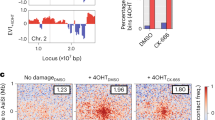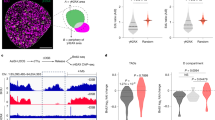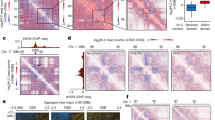Abstract
Genomic stability is maintained by the surveillance and repair of DNA damage. Here, we describe a mechanism whereby repair of extrachromosomal DNA double-strand breaks (DSBs) in human cells can be accompanied by capture of genomic DNA fragments. The availability of the human genome sequence enabled us to characterize these inserts in cells from a normal individual and from a patient with ataxia telangiectasia (AT), deficient for the damage response kinase ATM and prone to genomic instability. We find AT cells exhibit insertions of human chromosomal DNA fragments in excess of 17 kb during DSB repair, whereas we detected no such genomic inserts in normal cells. However, the presence of simian virus 40 (SV40), used to transform these cell lines, resulted in capture of genomic DNA associated with sites of viral integration in both cell types. The genomic instability at sites of SV40 integration was exported to other sites of DNA damage, and acquisition of the viral origin of replication resulted in gene amplification through autonomous replication of the plasmid harbouring the repaired extrachromosomal DSB. Should this same phenomenon apply to the repair of chromsomal DSBs, genome rearrangements made possible via this DSB insertional repair pose risks to genomic integrity, and may contribute to tumorigenic progression.
This is a preview of subscription content, access via your institution
Access options
Subscribe to this journal
Receive 50 print issues and online access
$259.00 per year
only $5.18 per issue
Buy this article
- Purchase on SpringerLink
- Instant access to full article PDF
Prices may be subject to local taxes which are calculated during checkout


Similar content being viewed by others
References
Allen C, Miller CA and Nickoloff JA . (2003). DNA Repair (Amst), 2, 1147–1156.
Benner SE, Wahl GM and Von Hoff DD . (1991). Anticancer Drugs, 2, 11–25.
Carbone M, Bocchetta M, Cristaudo A, Emri S, Gazdar A, Jasani B, Lednicky J, Miele L, Mutti L, Pass HI, Ramael M, Rizzo P, Testa JR, Weggen S and Yeung A . (2003). Int. J. Cancer, 106, 140–142.
Corbin S, Neilly ME, Espinosa III R, Davis EM, McKeithan TW and Le Beau MM . (2002). Cancer Res., 62, 3477–3484.
Cox R, Debenham PG, Masson WK and Webb MB . (1986). Mol. Biol. Med., 3, 229–244.
Croce CM . (1977). Proc. Natl. Acad. Sci. USA, 74, 315–318.
Dar ME, Winters TA and Jorgensen TJ . (1997). Mutat. Res./DNA Repair, 384, 169–179.
Fanning E and Knippers R . (1992). Annu. Rev. Biochem., 61, 55–85.
Garcea RL and Imperiale MJ . (2003). J. Virol., 77, 5039–5045.
Gazdar AF, Butel JS and Carbone M . (2002). Nat. Rev. Cancer, 2, 957–964.
Gorbunova V and Levy AA . (1997). Nucleic Acids Res., 25, 4650–4657.
Hara H and Kaji H . (1987). Exp. Cell Res., 168, 531–538.
Hirt B . (1967). J. Mol. Biol., 26, 365–369.
Huang KC, Yamasaki EF and Snapka RM . (1999). Virology, 262, 457–469.
Hwang SP and Kucherlapati R . (1980). Virology, 105, 196–204.
Jasani B, Cristaudo A, Emri SA, Gazdar AF, Gibbs A, Krynska B, Miller C, Mutti L, Radu C, Tognon M and Procopio A . (2001). Semin. Cancer Biol., 11, 49–61.
Kao C, Wu SQ, DeVries S, Reznikoff WS, Waldman FM and Reznikoff CA . (1993). Genes Chromosomes Cancer, 8, 155–166.
Kucherlapati R, Hwang SP, Shimizu N, McDougall JK and Botchan MR . (1978). Proc. Natl. Acad. Sci. USA, 75, 4460–4464.
Lednicky JA and Butel JS . (1997). J. Gen. Virol., 78, 1697–1705.
Li Y, Carty MP, Oakley GG, Seidman MM, Medvedovic M and Dixon K . (2001). Environ. Mol. Mutagen., 37, 128–140.
Lieber MR, Ma Y, Pannicke U and Schwarz K . (2003). Nat. Rev. Mol. Cell. Biol., 4, 712–720.
Lin Y and Waldman AS . (2001a). Genetics, 158, 1665–1674.
Lin Y and Waldman AS . (2001b). Nucleic Acids Res., 29, 3975–3981.
Lobrich M, Kuhne M, Wetzel J and Rothkamm K . (2000). Genes Chromosomes Cancer, 27, 59–68.
Marlhens F, Saint-Ruf C, Nardeux P, Lavialle C, Brouty-Boye D, Dutrillaux B and Cassingena R . (1988). Ann. Genet., 31, 81–86.
Maulbecker C, Mohr I, Gluzman Y, Bartholomew J and Botchan M . (1992). J. Virol., 66, 2195–2207.
Mendoza SM, Konishi T and Miller CW . (1998). Oncogene, 17, 2457–2462.
Meyn MS . (1993). Science, 260, 1327–1330.
Moore JK and Haber JE . (1996). Nature, 383, 644–646.
Murnane JP, Fuller LF and Painter RB . (1985). Exp. Cell. Res., 158, 119–126.
Popescu NC . (2003). Cancer Lett., 192, 1–17.
Powell S, Whitaker S, Peacock J and McMillan T . (1993). Mutat. Res., 294, 9–20.
Rabin M, Uhlenbeck OC, Steffensen DM and Mangel WF . (1984). J. Virol., 49, 445–451.
Ricchetti M, Fairhead C and Dujon B . (1999). Nature, 402, 96–100.
Roscheisen C, Haupter S, Zechner U and Speit G . (1994). Somat. Cell. Mol. Genet., 20, 493–504.
Roth DB and Wilson JH . (1986). Mol. Cell. Biol., 6, 4295–4304.
Runger TM, Poot M and Kraemer KH . (1992). Mutat. Res., 293, 47–54.
Salomon S and Puchta H . (1998). EMBO J., 17, 6086–6095.
Sargent RG, Brenneman MA and Wilson JH . (1997). Mol. Cell. Biol., 17, 267–277.
Schwab M . (1998). BioEssays, 20, 473–479.
Shera KA, Shera CA and McDougall JK . (2001). J. Virol., 75, 12339–12346.
Shivapurkar N, Harada K, Reddy J, Scheuermann RH, Xu Y, McKenna RW, Milchgrub S, Kroft SH, Feng Z and Gazdar AF . (2002). Lancet, 359, 851–852.
Singer MJ, Mesner LD, Friedman CL, Trask BJ and Hamlin JL . (2000). Proc. Natl. Acad. Sci. USA, 97, 7921–7926.
Stewart AR, Lednicky JA and Butel JS . (1998). J. Neurovirol., 4, 182–193.
Tachibana A and Sasaki MS . (2002). Biochem. Biophys. Res. Commun., 297, 275–281.
Tatsumi-Miyajima J, Yagi T and Takebe H . (1993). Mutat. Res., 294, 317–323.
Testa JR, Carbone M, Hirvonen A, Khalili K, Krynska B, Linnainmaa K, Pooley FD, Rizzo P, Rusch V and Xiao GH . (1998). Cancer Res., 58, 4505–4509.
Valerie K and Povirk LF . (2003). Oncogene, 22, 5792–5812.
Vilchez RA, Kozinetz CA, Arrington AS, Madden CR and Butel JS . (2003). Am. J. Med., 114, 675–684.
Vilenchik MM and Knudson AG . (2003). Proc. Natl. Acad. Sci. USA, 100, 12871–12876.
Wurtele H, Little KCE and Chartrand P . (2003). Gene Ther., 10, 1791–1799.
Yano O, Hirano H, Karasaki Y, Higashi K, Nakamura H, Akiya S and Gotoh S . (1991). Cell Struct. Funct., 16, 63–71.
Yu X and Gabriel A . (1999). Mol. Cell, 4, 873–881.
Zhou Y, Luoh SM, Zhang Y, Watanabe C, Wu TD, Ostland M, Wood WI and Zhang Z . (2003). Cancer Res., 63, 5781–5784.
Acknowledgements
We thank Hugo Wurtele for discussions and critical reading of the manuscript, and Nancy Ringuette for her assistance with FISH. Helpful information regarding SV40 and human cell lines was provided by Dr R Snapka and Dr J Lednicky (GM00637), and Dr J Murnane and Dr L Toji (GM05849). Kevin Little is the recipient of scholarships from the Fondation Marc Bourgie and the Canderel program. This work was supported by a grant from the Canadian Institutes of Health Research (CIHR).
Author information
Authors and Affiliations
Corresponding author
Rights and permissions
About this article
Cite this article
Little, K., Chartrand, P. Genomic DNA is captured and amplified during double-strand break (DSB) repair in human cells. Oncogene 23, 4166–4172 (2004). https://doi.org/10.1038/sj.onc.1207570
Received:
Revised:
Accepted:
Published:
Issue date:
DOI: https://doi.org/10.1038/sj.onc.1207570



